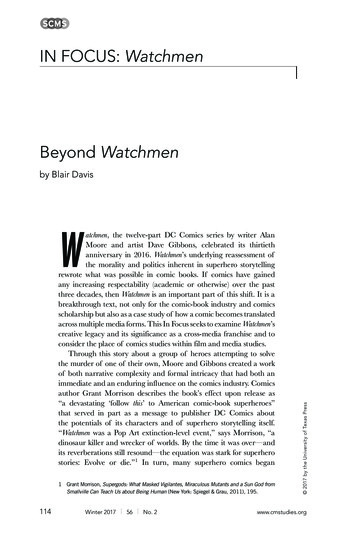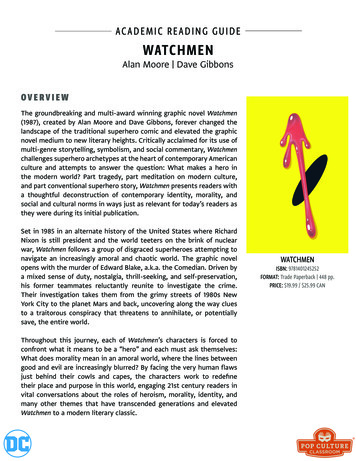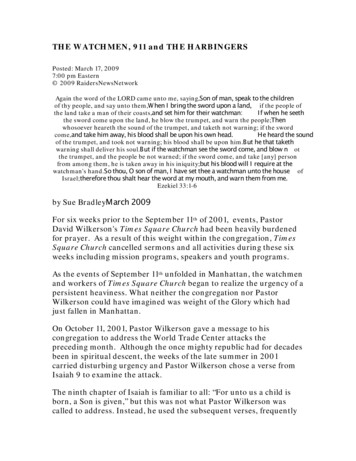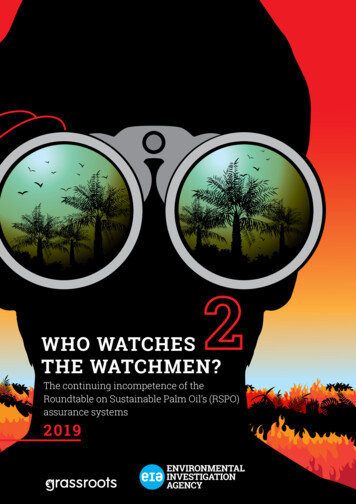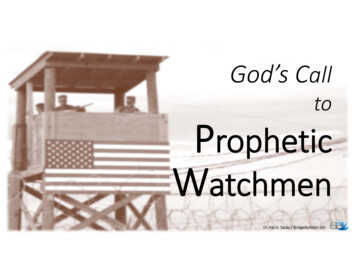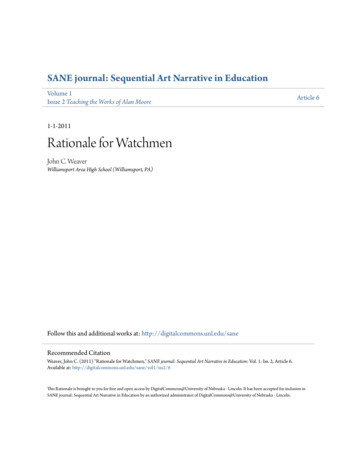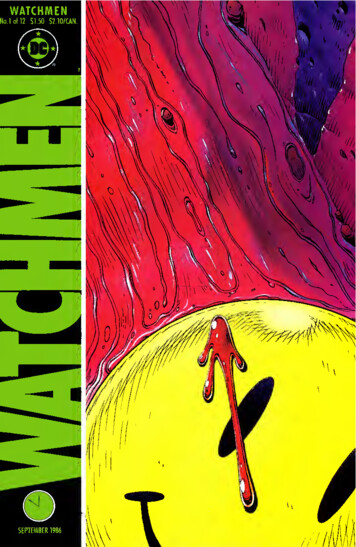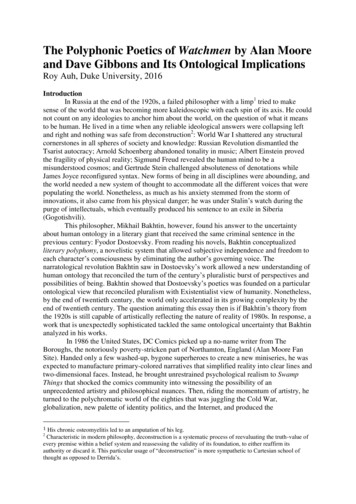
Transcription
The Polyphonic Poetics of Watchmen by Alan Mooreand Dave Gibbons and Its Ontological ImplicationsRoy Auh, Duke University, 2016IntroductionIn Russia at the end of the 1920s, a failed philosopher with a limp1 tried to makesense of the world that was becoming more kaleidoscopic with each spin of its axis. He couldnot count on any ideologies to anchor him about the world, on the question of what it meansto be human. He lived in a time when any reliable ideological answers were collapsing leftand right and nothing was safe from deconstruction2: World War I shattered any structuralcornerstones in all spheres of society and knowledge: Russian Revolution dismantled theTsarist autocracy; Arnold Schoenberg abandoned tonality in music; Albert Einstein provedthe fragility of physical reality; Sigmund Freud revealed the human mind to be amisunderstood cosmos; and Gertrude Stein challenged absoluteness of denotations whileJames Joyce reconfigured syntax. New forms of being in all disciplines were abounding, andthe world needed a new system of thought to accommodate all the different voices that werepopulating the world. Nonetheless, as much as his anxiety stemmed from the storm ofinnovations, it also came from his physical danger; he was under Stalin’s watch during thepurge of intellectuals, which eventually produced his sentence to an exile in Siberia(Gogotishvili).This philosopher, Mikhail Bakhtin, however, found his answer to the uncertaintyabout human ontology in a literary giant that received the same criminal sentence in theprevious century: Fyodor Dostoevsky. From reading his novels, Bakhtin conceptualizedliterary polyphony, a novelistic system that allowed subjective independence and freedom toeach character’s consciousness by eliminating the author’s governing voice. Thenarratological revolution Bakhtin saw in Dostoevsky’s work allowed a new understanding ofhuman ontology that reconciled the turn of the century’s pluralistic burst of perspectives andpossibilities of being. Bakhtin showed that Dostoevsky’s poetics was founded on a particularontological view that reconciled pluralism with Existentialist view of humanity. Nonetheless,by the end of twentieth century, the world only accelerated in its growing complexity by theend of twentieth century. The question animating this essay then is if Bakhtin’s theory fromthe 1920s is still capable of artistically reflecting the nature of reality of 1980s. In response, awork that is unexpectedly sophisticated tackled the same ontological uncertainty that Bakhtinanalyzed in his works.In 1986 the United States, DC Comics picked up a no-name writer from TheBoroughs, the notoriously poverty-stricken part of Northamton, England (Alan Moore FanSite). Handed only a few washed-up, bygone superheroes to create a new miniseries, he wasexpected to manufacture primary-colored narratives that simplified reality into clear lines andtwo-dimensional faces. Instead, he brought unrestrained psychological realism to SwampThings that shocked the comics community into witnessing the possibility of anunprecedented artistry and philosophical nuances. Then, riding the momentum of artistry, heturned to the polychromatic world of the eighties that was juggling the Cold War,globalization, new palette of identity politics, and the Internet, and produced the1His chronic osteomyelitis led to an amputation of his leg.Characteristic in modern philosophy, deconstruction is a systematic process of reevaluating the truth-value ofevery premise within a belief system and reassessing the validity of its foundation, to either reaffirm itsauthority or discard it. This particular usage of “deconstruction” is more sympathetic to Cartesian school ofthought as opposed to Derrida’s.2
Auh 2groundbreaking Watchmen. Portraying this unprecedentedly cacophonous reality was amission of the highest art forms, befitting explorations in literary environments inhabited bycharacters such as Kurt Vonnegut’s Billy Pilgrim, Samuel Beckett’s Pim, Gabriel GarciaMarquez’s Buendia, and Naguib Mahfouz’s Gebelaawi—not Captain America or theFantastic Four. However, Alan Moore shattered expectations and, collaborating with a Britishvirtuoso comics artist Dave Gibbons, produced Watchmen. This groundbreaking worksolidified his celebrity as an intellectual as much as it elevated Western comic books into“graphic novels,”3 a literary genre with enough sophistication for Watchmen to be ranked inTime Magazine’s “All-TIME 100 Novels” list. Not to be outshined by its companions in thatlist, Watchmen is a sobering meditation on its contemporary reality, especially thedisorienting and terrifying faces of human society. As Bakhtin had done, Moore also soughtto get a bearing on the nauseatingly complex world through art, and, as Dostoevsky had done,consequently employed a pluralistic narrative form. However, Moore distinguished hispluralist novelistic universe from them with characters that were of a unique, postmodernistontological composition—that reflects the fact that human complexity is not an innate humanquality to be celebrated, as Dostoevsky thought, but a reflection of a complex society humansare born into.ThesisIn this essay, I will show how Bakhtin analzyed Dostoevsky’s poetics as literarypolyphony, a narratological environment defined by fully developed pluralism of characters’consciousnesses, for a particular point of view on human ontology. He saw that Dostoevsky’snovelistic structure is founded on what Bakhtin coins the “unfinalizability” of man, or theinfinite nature of human consciousness and its consequent resistance to any staticdescriptions. As poetics are founded on a basis of the author’s personal ontological opinion,so this essay will summarize how polyphonic poetics is founded on ontological basis ofhuman unfinalizability.The second part of the essay will then analyze the different ontological justification ofpolyphonic poetics, specifically those advanced by Moore and Gibbons’s polyphonic graphicnovel Watchmen. I will first outline the various poetical techniques Watchmen uses. I willthen lay our how Watchmen’s innovations in the visual dimensions of the graphic novel addmeaning and understanding to our experience of polyphony. Watchmen’s use of the graphicform for polyphonic effect thus presents a more contemporary experience of polyphonicpoetics as the novel reflects a deepened kaleidoscopic uncertainty of human ontology andmeaning of life. I will argue that Moore and Gibbons’ polyphony finds its philosophicalinspiration in the ontological thesis that human, as an empty mirror to society, is,unfinalizable only because the society it reflects is unfinalizable. This is a revision ofBakhtin’s theory of unfinalizability he finds in Dostoevsky, and its placement in apostmodernist context: the source of human’s unfinalizability is not his or her innateconsciousness, which is what Dostoevsky writes about, but the society he or she is lodgedinto, which I argue is what Moore and Gibbons represent. This essay is thus about anontological shift of polyphonic poetics found in Watchmen’s graphic medium. Theformalistic and philosophical revision allows the readers a more contemporary experience ofliterary polyphony and its ontological framework.3This is a label used primarily by DC Comics to market Watchmen to a wider brand of audience. It is difficultto say scholarly that Watchmen is the first ‘graphic novel’ in this aspect, as well as considering the existence ofa rich tradition of sophisticated graphic novels in Asia that has been around since 1940s.
Auh 3What is Polyphony?The term literary polyphony was first introduced in 1929 in Bakhtin’s influentialProblems of Dostoevsky’s Poetics. In this book, Bakhtin describes Dostoevsky’s novelisticworlds as polyphonic, antithetical to traditional “monologic” novels. In music, polyphony is aphenomenon in which multiple voices, human or instrumental, sing out different notes butharmonize on a higher musical plane. However, novelistic polyphony is a concept entirelydifferent from its musicological counterpart. To understand what polyphonic novels are, it isparamount to know what they are not: monologic novels.In monologic novels, everything within its fictional universe happens and exists inservice of the author’s personal grand narrative, or the author’s “monologue.” There is, asBahktin writes, a “firm background of a unified world of objects” whose characters are itsflat murals by being “subordinated to the character’s objectified image as merely one of itscharacteristics” (Bakhtin 18, 7). Monologic novels are most easily identifiable by theirdidacticism—the entirety of the novelistic universe is watered down into the ‘bottom line’ ofthe tale, a consequence of the authors standing above their fictional universe and employingtheir own consciousness to govern each of their characters, essentially rendering them as hisor her marionettes at best. The fiction is rather an elaborate mouthpiece for the author, wherehis ideology and consciousness is the actual basis of each character’s words. Bakhtin claimsthat therefore, the novel have dominantly been single-voiced, that of the author’s singularperspective. In this monologic system, the author is raised to a deity that fated all that isaccording to his will.Writers of philosophical novels most often exercise this framework. For example,Voltaire’s vision is clearly outlined all throughout Candide. A quick-paced story of a princeand his tutor surviving a string of tragedies and accidents, Candide demonstrates howdifferent prominent ideologies fare in the face of all the misfortunes. Pangloss is theproponent of Leibnizian optimism4, or now thus renamed as Panglossianism5, and Candide isthe foiling pragmatist. Each character espouses only their specific ideology in response toeach event. It is the author’s will that both characters have become mouthpieces of singularphilosophies, and their thoughts are fully controlled by the author’s intentions. How Panglossand Candide each react to any events in the novel is automated by their governingphilosophies, which Voltaire placed to support his own vision. The characters, or the author’screations, have never even enjoyed any degree of free-thinking and self consciousness, andall that happens is the unchanging author’s will.However, as Bahktin explains, “Dostoevsky created a fundamentally new novelisticgenre, [where] a character’s word about himself and his word is just as fully weighted as theauthor’s word usually is” (Bakhtin 7). Dostoevsky’s novels are polyphonic, or multi-voiced,for they are governed by the voices of many independent consciousnesses. The author nolonger is disguised in many different characters; the author is one of many otherconsciousnesses in the novel. According to Bakhtin, Dostoevsky relinquished that deisticstatus of the monologic author by creating his polyphonic novels, in which he is not placedabove any of his characters and stand dimensionally side by side with them. In Dostoevsky’screated universes, each character is a “not voiceless slave [or] only objects of authorialdiscourse,” but another human being whose degree of consciousness and extent of subjectiveawareness is on par with Dostoevsky (Bakhtin 6). The characters are as conscious ofthemselves and their membership in a created literary world as their authors, and by virtue of4In his The Monadology, Gottfried Leibniz argues that this particular universe exists by God’s decision overmany other possible universes. God is always good and has sufficient reason for all his creations, and so thisuniverse that God chose over exists as the best of all possible worlds.5 Pangloss, fictional mentor to the protagonist Candide in Voltaire’s Candide, is known for explaining away allcircumstances as “everything is made for the best purpose all is for the best” (20).
Auh 4that dimensional self-awareness, they are written to enjoy enough existential freedom tocreate their own course of events as time flows. Dostoevsky conceived his characters to havesuch free will to be the “subjects of their own directly signifying discourse” (Bakhtin 7). Asthe characters now live by their own consciousness and free will, they are no longerfatalistically governed by a metaphysically dominant vision of the world. There is no“unfolding of material within the framework of its own monologic understanding” inDostoevsky’s novels (Bakhtin 18). Instead, each character will do what it will. They arebecome their own voice, roaring what they are, not conforming to the common vision of thenovel. Dostoevsky’s ontological viewpoint is that humans have free consciousness that isunbounded by any singular narrative, as Bakhtin verbalized. His novels reflecting thisontological foundation, different characters chart their own voice into the novel’senvironment, and thus the novel becomes polyphonic as distinct voices populate the novel. Itis the highest form of power the characters can have, to be able to enjoy equal amount of selfrepresentation and self-governing existence. The characters are not reduced into symbols,caricatures, or metaphors. In Bakhtin’s words, they are not finalized, or when the charactersare given finality in what they are, without room for any more development. To be finalizedis to reach an immanent final stage of what a character can be, represent, or vocalize. Forexample, the knight in shining armor is only a consciousnessless figurine of medieval justice,the damsel in distress is a doll labeled feminine powerlessness whose only justification is tobe an evidence of the knight’s justice, and the evil dragon exists only to be a foil to the knightas an object of the knight’s justice. All three characters exist not as living beings with theirown consciousnesses but as metaphoric sentences that supports the author’s thesis.Polyphonic novels refuse to finalize any of its characters in that way. Its characters are“voices [remaining] independent and, as such, are combine
3 This is a label used primarily by DC Comics to market Watchmen to a wider brand of audience. It is difficult to say scholarly that Watchmen is the first ‘graphic novel’ in this aspect, as well as considering the existence of a rich tradition of sophisticated graphic novels in Asia that has been around since 1940s. Auh 3 What is Polyphony? The term literary polyphony was first introduced .
